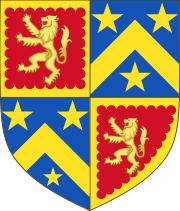Lord Shrewsbury
| Earldom of Shrewsbury held with Earldom of Waterford Earldom Talbot |
|
|---|---|
 
Quarterly, 1st and 4th: gules, a lion rampant within a bordure engrailed or (for Talbot), 2nd and 3rd: azure, a chevron between three mullets or (for Chetwynd).
|
|
| Creation date | 1074 (first creation) 1442 (second creation) |
| Monarch |
William I (first creation) Henry VI (second creation) |
| Peerage | Peerage of England |
| First holder | Roger de Montgomerie, 1st Earl of Shrewsbury (first creation) |
| Present holder | Charles Chetwynd-Talbot, 22nd Earl of Shrewsbury |
| Heir apparent | James Richard Charles John, Viscount Ingestre |
| Remainder to | Heirs male of the first earl's body lawfully begotten |
| Subsidiary titles | Viscount Ingestre Baron Talbot |
| Extinction date | 1102 (first creation) |
| Seat(s) | Wanfield Hall |
| Former seat(s) |
Ingestre Hall Alton Towers Sheffield Manor Wingfield Manor Alton Castle Barlow Woodseats Hall Grafton Manor Heythrop Park |
| Armorial motto | Prest d'Accomplir ("Ready to accomplish") |
Earl of Shrewsbury (/ˈʃroʊzbri/) is a hereditary title of nobility created twice in the Peerage of England. The second earldom dates to 1442. The holder of the Earldom of Shrewsbury also holds the title of Earl of Waterford (1446) in the Peerage of Ireland and Earl Talbot (1784) in the Peerage of Great Britain. The earldoms are the oldest held by someone with no higher title (the oldest earldoms in each peerage being held by the Duke of Norfolk and Duke of Leinster respectively), and as such the Earl of Shrewsbury is sometimes described as the premier earl of England and Ireland.
The first creation occurred in 1074 for Roger de Montgomerie, one of William the Conqueror's principal counselors. He was one of the Marcher Lords, with the Earl of Hereford and the Earl of Chester, a bulwark against the Welsh; he was granted great powers, and his territory, which extended from Shropshire (of which Shrewsbury is the county town) into Mid-Wales (the county of Montgomeryshire being named after him), was outside the ordinary administration; he was also granted lands across England.
Roger was succeeded in 1094 by his younger son Hugh, his elder son Robert of Bellême succeeding to his lands in Normandy. On Hugh’s death in 1098 the earldom passed to his brother Robert.
...
Wikipedia
